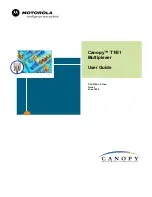
16
8786-A2-GZ40-20
February 2001
Table 8.
SNMP Traps Options
SNMP Traps
Possible Settings: Enable, Disable
Default Setting: Disable
Controls the generation of SNMP trap messages. The options for addresses and types
of traps are located in this table.
Number of Trap Managers
Possible Settings: 1, 2, 3, 4, 5
Default Setting: 1
Sets the number of SNMP management systems that will receive SNMP traps.
H
This field is not available when the unit is running in IP Conservative mode.
NMS n IP Address
Possible Settings: 001.000.000.000 – 223.255.255.255, Clear
Default Setting: 000.000.000.000
Specifies the Internet Protocol address used to identify each SNMP trap manager.
H
This field is not available when the unit is running in IP Conservative mode.
NMS n Destination
Possible Settings: IMC, DSL1, DSL2
Default Setting: IMC
Provides the network destination path of each trap manager.
H
NMS n Destination is available only when the unit is configured as an NTU and not
running in IP Conservative mode. Disabled ports cannot be specified.
General Traps
Possible Settings: Disable, Warm, AuthFail, Both
Default Setting: Both
Determines which SNMP traps are sent to each trap manager.
Enterprise Specific Traps
Possible Settings: Enable, Disable
Default Setting: Disable
Determines if SNMP traps are generated for enterprise-specific events.
Link Traps
Possible Settings: Disable, Up, Down, Both
Default Setting: Both
Determines if SNMP traps are generated for link up and link down for one of the
communication interfaces.
Link Trap Interfaces
Possible Settings: Network, G.703, All
Default Setting: All
Determines if the SNMP linkUp, SNMP linkDown, and interface-related
enterpriseSpecific traps are generated for the network DSL interface and/or G.703
interface (DTE).




































